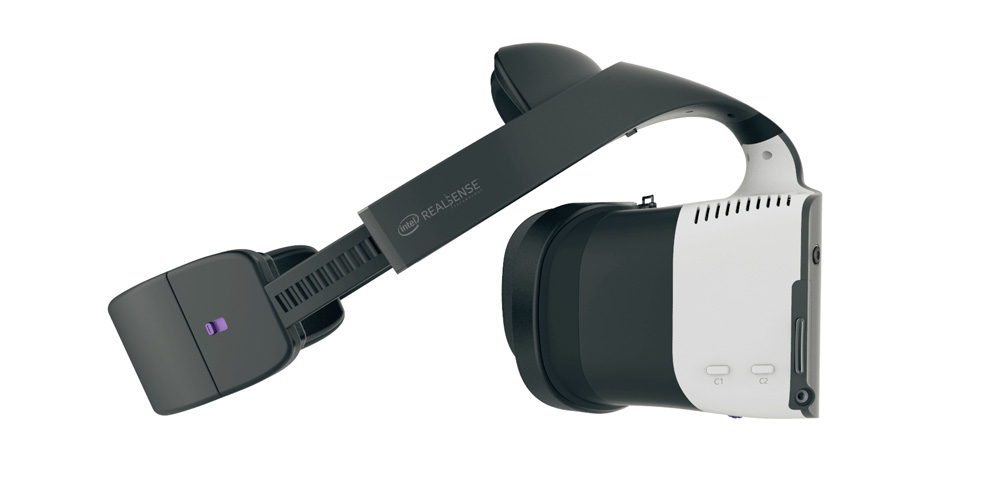How Revolutionary is Project Alloy: Intel’s New VR Tech?

On Tuesday, August 16, at Intel’s Developer Forum, Intel CEO Brian Krzanich unveiled Intel’s vision for the future of VR technology: Project Alloy. The “all-in-one” VR headset makes several tantalizing promises:
1) It will be a standalone VR solution, meaning it won’t require owning a powerful, expensive supercomputer.
2) It won’t have any cords or tethers to an external device, leaving the user free to move around without worrying about tripping or being pulled out of the experience.
3) It will offer “inside-out” 3D tracking, meaning that it will use sensors and cameras on the headset itself for tracking rather than relying on external cameras or sensors. With it, users won’t be confined to a small space defined by external camera or sensor placement such as the HTC Vive’s lighthouse tracking system. The headset can track itself anywhere.
4) It will offer hand and finger tracking capabilities, eliminating the need for controllers and giving its users use of their hands and fingers in VR, which will help users feel present in the virtual world while using the headset.
5) It will have pass-through cameras that allows for augmented reality (AR) capabilities (Intel is calling it “merged reality”).
With those major features in mind, you might be asking yourself: how game-changing can this product be in the VR market? The short answer is: with a sufficient amount of performance, this device, or one similar to it very well could be revolutionary. That being said, there are many hurdles that Intel needs to jump over to get there.
Aside from the five key features listed above and a demo video, Intel hasn’t released any specs for Project Alloy. Gauging by what we see from the video, the hand tracking had quite a low polygon count, potentially for combatting latency, a common concern with a wireless headset.
Another potential problem is that it’s difficult to see exactly where a device like this fits into the market. It’s highly doubtful that Project Alloy will have the same horsepower and performance that an Oculus-ready PC is going to have especially considering the fact that the headset will be spending resources doing its own tracking.
Gamers that value performance and higher end graphics are almost always going to opt for the HTC Vives and Oculus Rifts that provide a smoother, higher-res experience. On the other end of the spectrum, the casual consumer can just buy a cheap Gear VR or use a Google Cardboard viewer for a smart phone they already own rather than shelling out big money for a dedicated VR device.
Other factors such as screen resolution, field of view, battery life, latency, comfort, tracking capabilities, and price are all still unknowns at this time and will all heavily impact how well Project Alloy does.
No company has mastered untethered motion tracking yet. Problems with accuracy, latency, performance, and occlusion (things getting in the way of the cameras, such as a held object, or one arm being in front of the other) all stand in the way of its implementation. With VR, there is no room for error. To keep immersion, tracking needs to be incredibly precise, and it remains to be seen whether Project Alloy can offer that required level of precision.
Intel’s announcement of Project Alloy brings to mind the announcement of the Sulon Q, powered by AMD, earlier this year. The Sulon Q is a VR headset that promised many of the same features as Alloy such as being an all-in-one device with untethered, inside out tracking and a pass-through camera for AR. However, since Sulon’s last update in March, there has been no other information released on the VR headset.
At the end of the day, regardless of the viability of the product, it is good for VR that new competitors like Sulon and Intel are stepping up in the VR market.
Further Reading:
- Connected CE: Trends and Innovation
- The New Samsung Gear Won’t be the Gateway Drug to VR
- 2.3 million U.S. households own a virtual reality headset
Next: CEDIA 2016: CEDIA Session Recap of Growth & Future Outlook for the High-End Audio Market
Previous: How Cloud Connectivity Impacts Healthcare: Managing Chronic Diseases
Comments
-
Be the first to leave a comment.
Post a Comment
Have a comment? Login or create an account to start a discussion.


